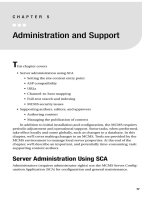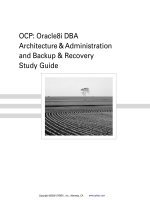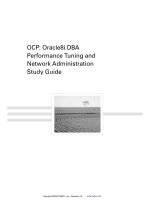Network Administration and Troubleshooting
Bạn đang xem bản rút gọn của tài liệu. Xem và tải ngay bản đầy đủ của tài liệu tại đây (4.97 MB, 36 trang )
PART VII
Network
Administration and
Troubleshooting
Chapter 16 Backing Up and Restoring Cisco IOS Software
and Configurations
Chapter 17 Password Recovery Procedures and the
Configuration Register
Chapter 18 Cisco Discovery Protocol (CDP)
Chapter 19 Telnet and SSH
Chapter 20 The ping and traceroute Commands
Chapter 21 SNMP and Syslog
Chapter 22 Basic Troubleshooting
This page intentionally left blank
CHAPTER 16
Backing Up and Restoring
Cisco IOS Software and
Configurations
This chapter provides information and commands concerning the following topics:
• Boot system commands
• The Cisco IOS File System
• Backing up configurations to a TFTP server
• Restoring configurations from a TFTP server
• Backing up the Cisco IOS Software to a TFTP server
• Restoring/upgrading the Cisco IOS Software from a TFTP server
• Restoring the Cisco IOS Software from ROM Monitor mode using Xmodem
• Restoring the Cisco IOS Software using the ROM Monitor environmental
variables and tftpdnld command
Boot System Commands
If you enter boot system flash first, that is the first place the router will go to look for
the Cisco IOS Software. If you want to go to a TFTP server first, make sure that the
boot system tftp command is the first one you enter.
Router(config)#bb
bb
oo
oo
oo
oo
tt
tt
ss
ss
yy
yy
ss
ss
tt
tt
ee
ee
mm
mm
ff
ff
ll
ll
aa
aa
ss
ss
hh
hh
image-
name
Loads the Cisco IOS
Software with image-name.
Router(config)#bb
bb
oo
oo
oo
oo
tt
tt
ss
ss
yy
yy
ss
ss
tt
tt
ee
ee
mm
mm
tt
tt
ff
ff
tt
tt
pp
pp
image-name
11
11
77
77
22
22
..
..
11
11
66
66
..
..
11
11
00
00
..
..
33
33
Loads the Cisco IOS
Software with image-name
from a TFTP server.
Router(config)#bb
bb
oo
oo
oo
oo
tt
tt
ss
ss
yy
yy
ss
ss
tt
tt
ee
ee
mm
mm
rr
rr
oo
oo
mm
mm
Loads the Cisco IOS
Software from ROM.
Router(config)#ee
ee
xx
xx
ii
ii
tt
tt
Router#cc
cc
oo
oo
pp
pp
yy
yy
rr
rr
uu
uu
nn
nn
nn
nn
ii
ii
nn
nn
gg
gg
--
--
cc
cc
oo
oo
nn
nn
ff
ff
ii
ii
gg
gg
ss
ss
tt
tt
aa
aa
rr
rr
tt
tt
uu
uu
pp
pp
--
--
cc
cc
oo
oo
nn
nn
ff
ff
ii
ii
gg
gg
Saves the running
configuration to NVRAM.
The router will execute
commands in their order
on the next reload.
186 Backing Up Configurations to a TFTP Server
The Cisco IOS File System
NOTE: The Cisco IOS File System (IFS) provides a single interface to all the file
systems available on a routing device, including the flash memory file system;
network file systems such as TFTP, Remote Copy Protocol (RCP), and File Transfer
Protocol (FTP); and any other endpoint for reading and writing data, such as
NVRAM, or the running configuration.
The Cisco IFS minimizes the required prompting for many commands. Instead
of entering in an EXEC-level copy command and then having the system prompt
you for more information, you can enter a single command on one line with
all necessary information.
Backing Up Configurations to a TFTP Server
Cisco IOS Software Commands IFS Commands
cc
cc
oo
oo
pp
pp
yy
yy
tt
tt
ff
ff
tt
tt
pp
pp
rr
rr
uu
uu
nn
nn
nn
nn
ii
ii
nn
nn
gg
gg
--
--
cc
cc
oo
oo
nn
nn
ff
ff
ii
ii
gg
gg
cc
cc
oo
oo
pp
pp
yy
yy
tt
tt
ff
ff
tt
tt
pp
pp
::
::
ss
ss
yy
yy
ss
ss
tt
tt
ee
ee
mm
mm
::
::
rr
rr
uu
uu
nn
nn
nn
nn
ii
ii
nn
nn
gg
gg
--
--
cc
cc
oo
oo
nn
nn
ff
ff
ii
ii
gg
gg
cc
cc
oo
oo
pp
pp
yy
yy
tt
tt
ff
ff
tt
tt
pp
pp
ss
ss
tt
tt
aa
aa
rr
rr
tt
tt
uu
uu
pp
pp
--
--
cc
cc
oo
oo
nn
nn
ff
ff
ii
ii
gg
gg
cc
cc
oo
oo
pp
pp
yy
yy
tt
tt
ff
ff
tt
tt
pp
pp
::
::
nn
nn
vv
vv
rr
rr
aa
aa
mm
mm
::
::
ss
ss
tt
tt
aa
aa
rr
rr
tt
tt
uu
uu
pp
pp
--
--
cc
cc
oo
oo
nn
nn
ff
ff
ii
ii
gg
gg
ss
ss
hh
hh
oo
oo
ww
ww
ss
ss
tt
tt
aa
aa
rr
rr
tt
tt
uu
uu
pp
pp
--
--
cc
cc
oo
oo
nn
nn
ff
ff
ii
ii
gg
gg
mm
mm
oo
oo
rr
rr
ee
ee
nn
nn
vv
vv
rr
rr
aa
aa
mm
mm
::
::
ss
ss
tt
tt
aa
aa
rr
rr
tt
tt
uu
uu
pp
pp
--
--
cc
cc
oo
oo
nn
nn
ff
ff
ii
ii
gg
gg
ee
ee
rr
rr
aa
aa
ss
ss
ee
ee
ss
ss
tt
tt
aa
aa
rr
rr
tt
tt
uu
uu
pp
pp
--
--
cc
cc
oo
oo
nn
nn
ff
ff
ii
ii
gg
gg
ee
ee
rr
rr
aa
aa
ss
ss
ee
ee
nn
nn
vv
vv
rr
rr
aa
aa
mm
mm
::
::
cc
cc
oo
oo
pp
pp
yy
yy
rr
rr
uu
uu
nn
nn
nn
nn
ii
ii
nn
nn
gg
gg
--
--
cc
cc
oo
oo
nn
nn
ff
ff
ii
ii
gg
gg
ss
ss
tt
tt
aa
aa
rr
rr
tt
tt
uu
uu
pp
pp
--
--
cc
cc
oo
oo
nn
nn
ff
ff
ii
ii
gg
gg
cc
cc
oo
oo
pp
pp
yy
yy
ss
ss
yy
yy
ss
ss
tt
tt
ee
ee
mm
mm
::
::
rr
rr
uu
uu
nn
nn
nn
nn
ii
ii
nn
nn
gg
gg
--
--
cc
cc
oo
oo
nn
nn
ff
ff
ii
ii
gg
gg
nn
nn
vv
vv
rr
rr
aa
aa
mm
mm
::
::
ss
ss
tt
tt
aa
aa
rr
rr
tt
tt
uu
uu
pp
pp
--
--
cc
cc
oo
oo
nn
nn
ff
ff
ii
ii
gg
gg
cc
cc
oo
oo
pp
pp
yy
yy
rr
rr
uu
uu
nn
nn
nn
nn
ii
ii
nn
nn
gg
gg
--
--
cc
cc
oo
oo
nn
nn
ff
ff
ii
ii
gg
gg
tt
tt
ff
ff
tt
tt
pp
pp
cc
cc
oo
oo
pp
pp
yy
yy
ss
ss
yy
yy
ss
ss
tt
tt
ee
ee
mm
mm
::
::
rr
rr
uu
uu
nn
nn
nn
nn
ii
ii
nn
nn
gg
gg
--
--
cc
cc
oo
oo
nn
nn
ff
ff
ii
ii
gg
gg
tt
tt
ff
ff
tt
tt
pp
pp
::
::
ss
ss
hh
hh
oo
oo
ww
ww
rr
rr
uu
uu
nn
nn
nn
nn
ii
ii
nn
nn
gg
gg
--
--
cc
cc
oo
oo
nn
nn
ff
ff
ii
ii
gg
gg
mm
mm
oo
oo
rr
rr
ee
ee
ss
ss
yy
yy
ss
ss
tt
tt
ee
ee
mm
mm
::
::
rr
rr
uu
uu
nn
nn
nn
nn
ii
ii
nn
nn
gg
gg
--
--
cc
cc
oo
oo
nn
nn
ff
ff
ii
ii
gg
gg
Denver#
cc
cc
oo
oo
pp
pp
yy
yy
rr
rr
uu
uu
nn
nn
nn
nn
ii
ii
nn
nn
gg
gg
--
--
cc
cc
oo
oo
nn
nn
ff
ff
ii
ii
gg
gg
ss
ss
tt
tt
aa
aa
rr
rr
tt
tt
uu
uu
pp
pp
--
--
cc
cc
oo
oo
nn
nn
ff
ff
ii
ii
gg
gg
Saves the running
configuration from DRAM
to NVRAM (locally).
Denver#cc
cc
oo
oo
pp
pp
yy
yy
rr
rr
uu
uu
nn
nn
nn
nn
ii
ii
nn
nn
gg
gg
--
--
cc
cc
oo
oo
nn
nn
ff
ff
ii
ii
gg
gg
tt
tt
ff
ff
tt
tt
pp
pp
Copies the running
configuration to the remote
TFTP server.
Address or name of remote host[ ]?
192.168.119.20
The IP address of the TFTP
server.
Restoring Configurations from a TFTP Server 187
NOTE: You can also use the preceding sequence for a copy startup-config tftp
command sequence.
Restoring Configurations from a TFTP Server
NOTE: You can also use the preceding sequence for a copy tftp startup-config
command sequence.
Destination Filename [Denver-confg]?®
The name to use for the file
saved on the TFTP server.
!!!!!!!!!!!!!!!
Each bang symbol (!) = 1
datagram of data.
624 bytes copied in 7.05 secs
Denver#
File has been transferred
successfully.
Denver#cc
cc
oo
oo
pp
pp
yy
yy
tt
tt
ff
ff
tt
tt
pp
pp
rr
rr
uu
uu
nn
nn
nn
nn
ii
ii
nn
nn
gg
gg
--
--
cc
cc
oo
oo
nn
nn
ff
ff
ii
ii
gg
gg
Copies the configuration
file from the TFTP server
to DRAM.
Address or name of remote host[ ]?
192.168.119.20
The IP address of the
TFTP server.
Source filename [ ]?Denver-confg
Enter the name of the file
you want to retrieve.
Destination filename [running-config]?
®
Accessing tftp://192.168.119.20/Denver-
confg…
Loading Denver-confg from 192.168.119.02
(via Fast Ethernet 0/0):
!!!!!!!!!!!!!!
[OK-624 bytes]
624 bytes copied in 9.45 secs
Denver#
File has been transferred
successfully.
188 Restoring/Upgrading the Cisco IOS Software from a TFTP Server
Backing Up the Cisco IOS Software to a TFTP Server
Restoring/Upgrading the Cisco IOS Software from a TFTP Server
Denver#cc
cc
oo
oo
pp
pp
yy
yy
ff
ff
ll
ll
aa
aa
ss
ss
hh
hh
tt
tt
ff
ff
tt
tt
pp
pp
Source filename [ ]? cc
cc
22
22
66
66
00
00
00
00
--
--
jj
jj
ss
ss
--
--
ll
ll
__
__
11
11
22
22
11
11
--
--
33
33
..
..
bb
bb
ii
ii
nn
nn
Name of the Cisco IOS
Software image.
Address or name of remote host [ ]?
11
11
99
99
22
22
..
..
11
11
66
66
88
88
..
..
11
11
11
11
99
99
..
..
22
22
00
00
The address of the TFTP
server.
Destination filename [c2600-js-l_121-3.bin]?
®
The destination filename
is the same as the source
filename, so just press
®.
!!!!!!!!!!!!!!!!!!!!!!!!!!!!!!!!!!!!!!!!!!!!!!
!!!!!!!!!!!!!!!!!!!!!!!!!!!!!!!!!!!!!!
8906589 bytes copied in 263.68 seconds
Denver#
Denver#
cc
cc
oo
oo
pp
pp
yy
yy
tt
tt
ff
ff
tt
tt
pp
pp
ff
ff
ll
ll
aa
aa
ss
ss
hh
hh
Address or name of remote host [ ]?
11
11
99
99
22
22
..
..
11
11
66
66
88
88
..
..
11
11
11
11
99
99
..
..
22
22
00
00
Source filename [ ]?
cc
cc
22
22
66
66
00
00
00
00
--
--
jj
jj
ss
ss
--
--
ll
ll
__
__
11
11
22
22
11
11
--
--
33
33
..
..
bb
bb
ii
ii
nn
nn
Destination filename [c2600-js-l_121-
3.bin]?
®
Accessing tftp://192.168.119.20/c2600-js-
l_121-3.bin
Erase flash: before copying? [confirm]
®
If flash memory is full, erase
it first.
Erasing the flash file system will remove
all files
Continue? [confirm] ®
Press Ç-C if you want to
cancel.
Restoring the Cisco IOS Software from ROM Monitor Mode Using Xmodem 189
Restoring the Cisco IOS Software from ROM Monitor Mode Using
Xmodem
The output that follows was taken from a 1720 router. Some of this output might vary from
yours, depending on the router model that you are using.
Erasing device eeeeeeeeeeeeeeeeee…erased
Each e represents data being
erased.
Loading c2600-js-l_121-3.bin from
192.168.119.20
(via) FastEthernet 0/0):
!!!!!!!!!!!!!!!!!!!!!!!!!!!!!!!!!!!!!!!!!!!!
!!!!!!!!!!!!!!!!!!!!!!!!!!!!!!!!!!!!!!!!!!!!
!!!
Each bang symbol (!) = 1
datagram of data.
Verifying Check sum ……………… OK
[OK – 8906589 Bytes]
8906589 bytes copied in 277.45 secs
Denver#
Success.
rommon 1 >cc
cc
oo
oo
nn
nn
ff
ff
rr
rr
ee
ee
gg
gg
Shows the configuration summary.
Step through the questions,
answering defaults until you can
change the console baud rate.
Change it to 115200; it makes
transfer go faster.
Configuration Summary
enabled are:
load rom after netboot fails
console baud: 9600
boot: image specified by the boot system
commands
or default to: cisco2-c1700
190 Restoring the Cisco IOS Software from ROM Monitor Mode Using Xmodem
do you wish to change the configuration?
y/n [n]:
yy
yy
enable “diagnostic mode”? y/n [n]: nn
nn
enable “use net in IP bcast address”?
y/n [n]:
nn
nn
disable “load rom after netboot
fails”? y/n [n]:
nn
nn
enable “use all zero broadcast”? y/n
[n]:
nn
nn
enable “break/abort has effect”? y/n
[n]:
nn
nn
enable “ignore system config info”?
y/n [n]:
nn
nn
change console baud rate? y/n [n]: yy
yy
enter rate: 0=9600, 1=4800, 2=1200,
3=2400
4=19200, 5=38400, 6=57600,
7=115200 [0]:
77
77
change the boot characteristics? y/n
[n]:
nn
nn
Prompts begin to ask a series of
questions that allow you to change
the configuration register. Answer n
to all questions except the one that
asks you to change the console
baud rate. For the enter rate, choose
7 because that is the number that
represents a baud rate of 115200.
Configuration Summary
enabled are:
load rom after netboot fails
console baud: 115200
boot: image specified by the boot system
commands
or default to: cisco2-c1700
do you wish to change the configuration?
y/n [n]:
nn
nn
rommon2>
After the summary is shown again,
choose n to not change the
configuration and go to the
rommon> prompt again.
rommon 2>rr
rr
ee
ee
ss
ss
ee
ee
tt
tt
Reloads the router at the new com
speed. Change the HyperTerminal
setting to 115200 to match the
router’s new console setting.
Rommon 1>xx
xx
mm
mm
oo
oo
dd
dd
ee
ee
mm
mm
cc
cc
11
11
77
77
00
00
00
00
--
--
jj
jj
ss
ss
--
--
ll
ll
__
__
11
11
22
22
11
11
--
--
33
33
..
..
bb
bb
ii
ii
nn
nn
Asking to transfer this image using
Xmodem.
…<output cut>…
Restoring the Cisco IOS Software from ROM Monitor Mode Using Xmodem 191
Figure 16-1 Finding the Cisco IOS Software Image File
Do you wish to continue? y/n [n ]:yy
yy
Choose y to continue.
In HyperTerminal, go to Transfer,
then Send File (see Figure 16-1).
Locate the Cisco IOS Software file
on the hard drive and click Send
(see Figure 16-2).
Router will reload when transfer is completed.
Reset baud rate on router.
Router(config)#ll
ll
ii
ii
nn
nn
ee
ee
cc
cc
oo
oo
nn
nn
00
00
Router(config-line)#ss
ss
pp
pp
ee
ee
ee
ee
dd
dd
99
99
66
66
00
00
00
00
Router(config-line)#ee
ee
xx
xx
ii
ii
tt
tt
HyperTerminal will stop
responding. Reconnect to the router
using 9600 baud, 8-N-1.
192 Restoring IOS software using tftpdnld
Figure 16-2 Sending the Cisco IOS Software Image File to the Router
Restoring the Cisco IOS Software Using the ROM Monitor
Environmental Variables and tftpdnld Command
NOTE: Commands and environmental variables are case sensitive, so be sure
that you have not accidentally added spaces between variables and answers.
rommon 1>II
II
PP
PP
__
__
AA
AA
DD
DD
DD
DD
RR
RR
EE
EE
SS
SS
SS
SS
==
==
11
11
99
99
22
22
..
..
11
11
66
66
88
88
..
..
11
11
00
00
00
00
..
..
11
11
Indicates the IP address for this
unit.
rommon 2>II
II
PP
PP
__
__
SS
SS
UU
UU
BB
BB
NN
NN
EE
EE
TT
TT
__
__
MM
MM
AA
AA
SS
SS
KK
KK
==
==
22
22
55
55
55
55
..
..
22
22
55
55
55
55
..
..
22
22
55
55
55
55
..
..
00
00
Indicates the subnet mask for this
unit.
rommon 3>DD
DD
EE
EE
FF
FF
AA
AA
UU
UU
LL
LL
TT
TT
__
__
GG
GG
AA
AA
TT
TT
EE
EE
WW
WW
AA
AA
YY
YY
==
==
11
11
99
99
22
22
..
..
11
11
66
66
88
88
..
..
11
11
00
00
00
00
..
..
11
11
Indicates the default gateway for
this unit.
rommon 4>TT
TT
FF
FF
TT
TT
PP
PP
__
__
SS
SS
EE
EE
RR
RR
VV
VV
EE
EE
RR
RR
==
==
11
11
99
99
22
22
..
..
11
11
66
66
88
88
..
..
11
11
00
00
00
00
..
..
22
22
Indicates the IP address of the
TFTP server.
rommon 5>TT
TT
FF
FF
TT
TT
PP
PP
__
__
FF
FF
II
II
LL
LL
EE
EE
==
==
cc
cc
22
22
66
66
00
00
00
00
--
--
jj
jj
ss
ss
--
--
ll
ll
__
__
11
11
22
22
11
11
--
--
33
33
..
..
bb
bb
ii
ii
nn
nn
Indicates the filename to fetch
from the TFTP server.
rommon 6>tt
tt
ff
ff
tt
tt
pp
pp
dd
dd
nn
nn
ll
ll
dd
dd
Starts the process.
…<output cut>…
Do you wish to continue? y/n: [n]:
yy
yy
…<output cut>…
Rommon 7>
ii
ii
Resets the router. The i stands for
initialize.
CHAPTER 17
Password-Recovery
Procedures and the
Configuration Register
This chapter provides information and commands concerning the following topics:
• The configuration register
— A visual representation
— What the bits mean
— The boot field
— Console terminal baud rate settings
— Changing the console line speed: CLI
— Changing the console line speed: ROM Monitor mode
• Password-recovery procedures for Cisco routers
• Password-recovery procedures for 2960 series switches
The Configuration Register
A Visual Representation
The configuration register is a 16-bit field stored in NVRAM. The bits are numbered
from 15 to 0 looking at the bit stream from left to right. Bits are split up into groups
of 4, and each group is represented by a hexadecimal digit.
router#ss
ss
hh
hh
oo
oo
ww
ww
vv
vv
ee
ee
rr
rr
ss
ss
ii
ii
oo
oo
nn
nn
The last line of output tells you what
the configuration register is set to.
router#cc
cc
oo
oo
nn
nn
ff
ff
ii
ii
gg
gg
uu
uu
rr
rr
ee
ee
tt
tt
ee
ee
rr
rr
mm
mm
ii
ii
nn
nn
aa
aa
ll
ll
Moves to global configuration mode.
router(config)#cc
cc
oo
oo
nn
nn
ff
ff
ii
ii
gg
gg
--
--
rr
rr
ee
ee
gg
gg
ii
ii
ss
ss
tt
tt
ee
ee
rr
rr
00
00
xx
xx
22
22
11
11
44
44
22
22
Changes the configuration register
to 2142.
15 14 13 12 11 10 9 8 7 6 5 4 3 2 1 0 Bit places
0 0 1 0 0 0 0 1 0 1a 0 0 0 0 1 0 Register bits
2 1 4 2 Bits represented in hex
194 The Configuration Register
What the Bits Mean
The Boot Field
NOTE: Even though there are 16 possible combinations in the boot field, only
3 are used.
TIP: Because the default boot field has 14 different ways to represent it, a
configuration register setting of 0x2102 is the same as 0x2109, or 210F. The boot
system command is described in Chapter 16, “Backing Up and Restoring Cisco
IOS Software and Configurations.”
Bit Number Hexadecimal Meaning
00–03 0x0000–0x000F Boot field.
06 0x0040 Ignore NVRAM contents.
07 0x0080 OEM bit enabled.
08 0x0100 Break disabled.
09 0x0200 Causes system to use secondary bootstrap
(typically not used).
10 0x0400 IP broadcast with all 0s.
5, 11, 12 0x0020, 0x0800,
0x1000
Console line speed.
13 0x2000 Boots default ROM software if network boot fails.
14 0x4000 IP broadcasts do not have net numbers.
15 0x8000 Enables diagnostic messages and ignores NVRAM
contents.
Boot Field Meaning
00 Stays at the ROM Monitor on a reload or power cycle
01 Boots the first image in flash memory as a system image
02–F Enables default booting from flash memory
Enables boot system commands that override default booting from
flash memory
The Configuration Register 195
Console Terminal Baud Rate Settings
Changing the Console Line Speed: CLI
TIP: Cisco IOS Software does not allow you to change the console speed bits
directly with the config-register command.
Changing the Console Line Speed: ROM Monitor Mode
Baud Bit 5 Bit 12 Bit 11
115200 1 1 1
57600 1 1 0
38400 1 0 1
19200 1 0 0
9600 0 0 0
4800 0 0 1
2400 0 1 1
1200 0 1 0
router#cc
cc
oo
oo
nn
nn
ff
ff
ii
ii
gg
gg
uu
uu
rr
rr
ee
ee
tt
tt
ee
ee
rr
rr
mm
mm
ii
ii
nn
nn
aa
aa
ll
ll
router(config)#ll
ll
ii
ii
nn
nn
ee
ee
cc
cc
oo
oo
nn
nn
ss
ss
oo
oo
ll
ll
ee
ee
00
00
Enters console line mode
router(config-line)#ss
ss
pp
pp
ee
ee
ee
ee
dd
dd
11
11
99
99
22
22
00
00
00
00
Changes speed to 19200 baud
rommon1>cc
cc
oo
oo
nn
nn
ff
ff
rr
rr
ee
ee
gg
gg
Shows configuration
summary. Step through
the questions,
answering with the
defaults until you can
change the console
baud rate.
Configuration Summary
enabled are:
load rom after netboot fails
console baud: 9600
boot: image specified by the boot system commands
or default to:
x
(name of system image)
196 Password-Recovery Procedures for Cisco Routers
TIP: Make sure that after you change the console baud rate, you change your
terminal program to match the same rate!
Password-Recovery Procedures for Cisco Routers
do you wish to change the configuration? y/n [n]: yy
yy
enable “diagonstic mode”? y/n [n]: nn
nn
enable “use net in IP bcast address”? y/n [n]: nn
nn
disable “load rom after netboot fails”? y/n [n]: nn
nn
enable “use all zero broadcast”? y/n [n]: nn
nn
enable “break/abort has effect”? y/n [n]: nn
nn
enable “ignore system config info”? y/n [n]: nn
nn
change console baud rate? y/n [n]: yy
yy
enter rate: 0=9600, 1=4800, 2=1200, 3=2400
4=19200, 5=38400, 6=57600, 7=115200
[0]:
77
77
Configuration Summary
enabled are:
load rom after netboot fails
console baud: 115200
boot: image specified by the boot system commands
or default to:
x
(name of system image)
change the boot characteristics? y/n [n]:
nn
nn
After the summary is
shown again, choose n
to not change the
configuration and go to
the rommon>prompt
again.
rommon2>
Step 2500 Series Commands
1700/2600/ISR Series
Commands
Step 1: Boot the router
and interrupt the boot
sequence as soon as text
appears on the screen.
Press Ç-ı
>
Press Ç-ı
rommon 1>









